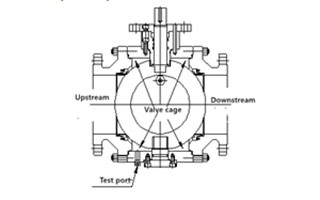Valve pressure test of DBB and DIB ball valve
DBB (double block and bleed valve) and DIB (double isolation and bleed valve) are two kinds of commonly used seat sealing structures for trunnion mounted ball valves. According to API 6D, DBB ball valve is a single valve with two sealed auxiliary, the closed position of which provides the pressure seal at both ends of the valve by means of bleed of the body cavity between the two seal surfaces, if the first seal leaks, the second will not seal in the same direction. DIB ball valve is a single valve with two seating surfaces, each of these seal seat provides a single source of pressure seal in the closed position by discharging the valve chamber between the seal seats.
The pressure test of the DBB valve:
 The valve is partially opened so that the experimental flow is fully injected into the valve chamber, and then the valve is closed so that the bleeding of the valve body is open and the excess medium is allowed to overflow from the valve chamber test junction. Pressure should be applied simultaneously from both ends of the valve to monitor seat tightness through overflow at the valve chamber test junction. The figure below shows a typical DBB ball valve configuration.
The valve is partially opened so that the experimental flow is fully injected into the valve chamber, and then the valve is closed so that the bleeding of the valve body is open and the excess medium is allowed to overflow from the valve chamber test junction. Pressure should be applied simultaneously from both ends of the valve to monitor seat tightness through overflow at the valve chamber test junction. The figure below shows a typical DBB ball valve configuration.
When the valve is closed and the valve chamber test port is opened and both ends of the valve are pressurized (or pressurized separately), the valve chamber port detects leakage from each end to the valve chamber. Theoretically, DBB valve can not provide positive double isolation when only one side is under pressure, the valve does not provide positive double isolation when only one side is under pressure.
The pressure test of DIB-1(Two bi-directional sealing seats)
 Each seat shall be tested in both directions and the installed cavity pressure relief valve shall be removed. The valve shall be half-opened so that the valve and valve chamber shall be injected with the test medium until the test liquid spills through the test port of the valve chamber. Close the valve to prevent leakage of the chamber in the direction of the test seat, the test pressure shall be applied successively to each end of the valve to test the leakage of each seat upstream separately, and then to test each seat as the downstream seat. Open both ends of the valve to fill the cavity with media and then pressurize while observing leakage of each seat at both ends of the valve.
Each seat shall be tested in both directions and the installed cavity pressure relief valve shall be removed. The valve shall be half-opened so that the valve and valve chamber shall be injected with the test medium until the test liquid spills through the test port of the valve chamber. Close the valve to prevent leakage of the chamber in the direction of the test seat, the test pressure shall be applied successively to each end of the valve to test the leakage of each seat upstream separately, and then to test each seat as the downstream seat. Open both ends of the valve to fill the cavity with media and then pressurize while observing leakage of each seat at both ends of the valve.
Because the pressure in the cavity of the DIB-1 valve cannot be released automatically, when the temperature of the valve is abnormally raised, the volume of the medium in the valve cavity increases accordingly, thus forcing the pressure in the cavity to increase automatically. When the pressure reaches a certain level, it will be very dangerous, so the cavity of the DIB-1 valve must be installed with a safety valve.
The pressure test of DIB-2(One bi-directional and one unidirectional sealing seat)
One of the seats of the DIB-2 valve can withstand pressure from either the chamber or the end of the valve in any direction without leakage. The other seat can only withstand pressure from the end of the valve. When the valve is closed and the valve chamber test interface is open and both ends of the valve are pressurized (or pressurized separately), the valve chamber test interface can detect whether there is leakage from each end to the valve chamber. Two-way seat test should be pressurized valve chamber and valve upstream observe whether the downstream valve leakage.
The advantage of the valve is tight protection for the valve, the valve closed after the medium will never enter the pipeline downstream, at the same time when the cavity pressure abnormal rise can automatically pressure relief to the upstream of the valve. Please note that the valve installation direction requirements, the opposite direction is the same as DBB.
Both DBB and DIB valves have their unique application and media, and various environmental challenges where critical isolation is needed to ensure that leakage does not occur such as LNG, petrochemical, transmission and storage, natural gas industrial processes, mainline and manifold valves in liquid pipelines, and refined products transmission lines.



Leave a Reply
Want to join the discussion?Feel free to contribute!